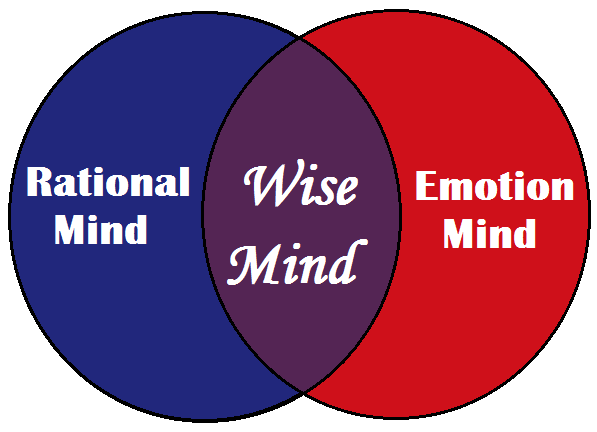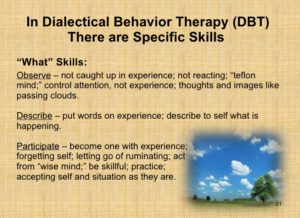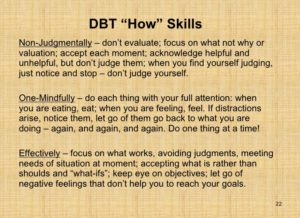DBT Mindfulness exercises
DBT Mindfulness Exercises

DBT Mindfulness Exercises
by Janette Grant 5th January 2018

Dialectical Behavioural Therapy (DBT) is a type of cognitive behavioural therapy and mindfulness is a key skill taught in DBT as it helps patients in raising awareness of their own thoughts and feelings. The simple DBT mindfulness exercises have expanded into treating a number of different patients, including those with severe anxiety. The exercises can teach people how to slow the pace of their thoughts, recognise them for what they are – just thoughts -and sharpen their focus. It also helps to address their anxiety issues in a real way and thus healing them rather than just masking them.
DBT Therapeutic Activity Ideas for Working with Teens
DBT mindfulness exercises were first added to general psychiatric treatments for various mental health problems, to help patients achieve the wise mind and focused on two sets of skills:
 The ‘What’ skills helped the patients to learn how to simply observe their experience; describe this experience using verbal labels; and to be fully present in the moment and in their actions without feeling self-conscious. These skills allow the patient to be aware of what is happening to them and of their part in their own experience. Being more aware of their own thoughts and more grounded in the present sets the foundation for the other set of ‘how’ skills.
The ‘What’ skills helped the patients to learn how to simply observe their experience; describe this experience using verbal labels; and to be fully present in the moment and in their actions without feeling self-conscious. These skills allow the patient to be aware of what is happening to them and of their part in their own experience. Being more aware of their own thoughts and more grounded in the present sets the foundation for the other set of ‘how’ skills.
The ‘How’ skills teach people how to observe, describe and  participate in their own experience. These skills help in learning how to have experiences in a non-evaluative and non-judgmental way; to focus on one thing at a time and learn to bring their attention back to the goal when they go off course; and to keep their focus on their goals regardless of their current mood.
participate in their own experience. These skills help in learning how to have experiences in a non-evaluative and non-judgmental way; to focus on one thing at a time and learn to bring their attention back to the goal when they go off course; and to keep their focus on their goals regardless of their current mood.
Patients were introduced to various mindfulness exercises including mindful breathing, the body scan and other simple awareness practices. Some of these exercises are mentioned below and have been shown to be of enormous help.
The Dialectical Behaviour Therapy Skills Workbook
5 DBT Mindfulness exercises
These are simple and quick exercises for anxiety which can easily slot into our everyday life and practising them regularly will make an enormous difference to our level of anxiety.
- Observe a leaf – pick a leaf and hold it in your hands and fully
 focus your attention on it. Take note of the physical characteristics of it – noticing the colour, shape, texture and pattern, without judging them as good or bad, beautiful or ugly. We should not assess or think about the leaf, but just observe it for what it is. This will help bring you into the present.
focus your attention on it. Take note of the physical characteristics of it – noticing the colour, shape, texture and pattern, without judging them as good or bad, beautiful or ugly. We should not assess or think about the leaf, but just observe it for what it is. This will help bring you into the present. - Mindful eating – this can be done using the raisin exercise on our Mindfulness exercises page or you can pick any food you enjoy and pay attention to what you are holding, noticing how it feels in your hands. Observe the texture, the weight, the colour etc., before bringing your awareness to the smell. Now put a little of it into your mouth and notice the taste and its texture on your tongue. This will give you a a new experience with a familiar food.

- Observe your thoughts – sit comfortably, or lie down on your back. If you are sitting, keep your back straight, but release the tension in your shoulders and let them drop. Close your eyes and focus on your breathing, taking notice of how your body feels as you slowly breathe in and out. Become completely immersed in the experience and imagine you are riding the waves of your own breath. Now move your attention to your thoughts, becoming aware of any that enter your mind. Try to see them just as thoughts – mere events just happening in your mind. If it helps, you can imagine them as clouds passing along, or leaves floating down a stream. Notice the thoughts enter your consciousness, but then just let them disappear on their own – no need to hold onto them. If you find yourself becoming sidetracked by a thought, just notice what diverted you from observing your thoughts and then gently bring yourself back to observing. After a few minutes you should shift your attention back to your breathing and open your eyes when ready.
- Mindfulness Bell exercise – begin by closing your eyes and listening for the bell and as soon as you hear it, you need to focus on the sound and keep focusing until it completely fades away. This will help to keep you firmly grounded in the present. This audio will help:
- Stare at the centre exercise – this is similar to staring into a candle flame and the aim is simply to focus your attention on the centre of the shifting pattern of colour. This exercise can bring focus and deep thought – your mind may wander, with thoughts coming into your head – but you should let those thoughts pass and stay in the present moment. You can use this below:
These simple DBT Mindfulness exercises all help to fully bring you into the present moment and are an enormous aid in reducing anxiety. The Observe your thoughts exercise can apply to any situation where anxiety is felt, when you can use your ‘observer mind to simply slow down, step back and calm your anxiety. We should all look to use this skill today!

‘If a person’s basic state of mind is serene and calm, then it is possible for this inner peace to overwhelm a painful physical experience’ – The Dalai Lama
Mindfulness Exercises for DBT Therapists – a compilation of mindfulness exercises for DBT Skills groups
-

 mindfulness9 months ago
mindfulness9 months agoFun Mindfulness exercises for groups
-

 mindfulness9 months ago
mindfulness9 months agoChocolate Mindfulness Script
-

 mindfulness8 months ago
mindfulness8 months agoMindfulness of thoughts
-

 anger management8 months ago
anger management8 months agoMindfulness for Anger Management
-

 mindfulness9 months ago
mindfulness9 months agoMindfulness activities, exercises and techniques for anxiety








